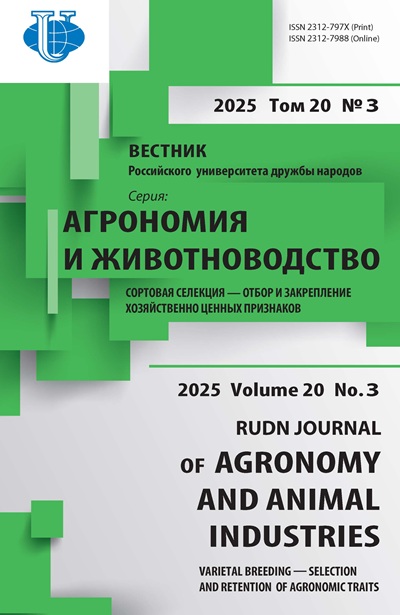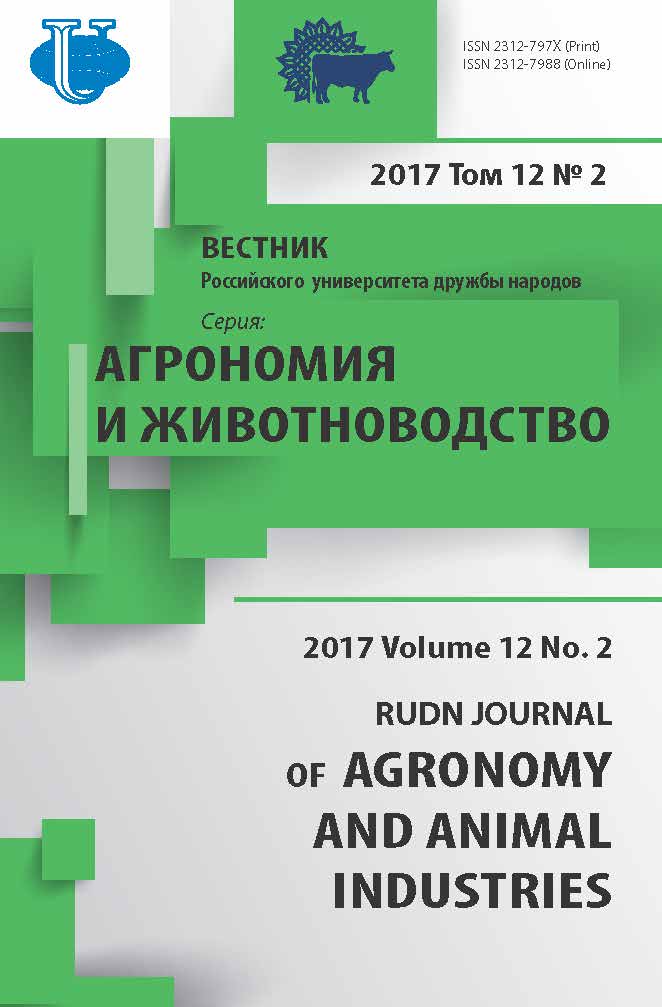Подбор клеточной культуры для накапливания in vitro вируса мешотчатого расплода пчел
- Авторы: Калинин А.Г.1, Гальнбек Т.В.2, Куликов Е.В.1
-
Учреждения:
- Российский университет дружбы народов
- ФГБНУ Всероссийский научно-исследовательский институт экспериментальной ветеринарии им. Я.Р. Коваленко
- Выпуск: Том 12, № 2 (2017)
- Страницы: 168-176
- Раздел: Ветеринария
- URL: https://agrojournal.rudn.ru/agronomy/article/view/16231
- DOI: https://doi.org/10.22363/2312-797X-2017-12-2-168-176
- ID: 16231
Цитировать
Полный текст
Аннотация
Проблемой своевременной диагностики является недоступность метода культивирования клеток in vitro вирусов пчел, из-за чего ограничивается понимание биологических механизмов, лежащих в основе вирусных заболеваний. Данные затруднения в работе вирусологов приводят к несвоевременной диагностике заболеваний и, как следствие, большим потерям в хозяйствах. В настоящее время существует очень мало сведений о культивировании вирусов пчел на гетерогенных клеточных культурах, дающих после пассажа патогена какие-либо дегенеративные изменения. Однако в последние годы идет активный спор по культивированию вирусов пчел на клеточных культурах. Уже сейчас стало известно, что наибольшей чувствительностью к вирусу мешотчатого расплода относятся эксплантаты яичников нимф маток пчел, культуры куриных фибробластов, ткань пчелиных фибробластов из грудных мышц взрослой пчелы, культуры тканей из репродуктивных органов, мышц и яиц пчелы первичнотрипсинизированная культура почек обезьян, первичная культура клеток, полученная от личинок рабочих пчел, культуры ПК-15, IBRS. Основная проблема культивирования вирусов пчел - малое количество данных о чувствительных клеточных культурах гетерологического типа. Однако исследования в данной области продолжаются, и ученые во всех странах мира пытаются решить серьезную задачу культивирования вирусов пчел. Основная проблема культивирования вирусов пчел - малое количество данных о чувствительных клеточных культурах гетерологического типа. Однако исследования в данной области продолжаются, и ученые во всех странах мира пытаются решить серьезную задачу культивирования вирусов пчел. В этой связи дать аналитический обзор по клеточному культивированию вирусов мешотчатого расплода пчел является определенной потребностью для правильного подхода к алгоритму диагностики.
Об авторах
Андрей Геннадьевич Калинин
Российский университет дружбы народов
Автор, ответственный за переписку.
Email: kalinin.andrew2010@yandex.ru
ФГБНУ Всероссийский научно-исследовательский институт экспериментальной ветеринарии им. Я.Р. Коваленко Рязанский проспект, 24-1, Москва, Россия, 109428
ул. Миклухо-Маклая, 8/2, Москва, Россия, 117198Татьяна Валерьевна Гальнбек
ФГБНУ Всероссийский научно-исследовательский институт экспериментальной ветеринарии им. Я.Р. Коваленко
Email: admin@viev.ru
Рязанский проспект, 24-1, Москва, Россия, 109428
Евгений Владимирович Куликов
Российский университет дружбы народов
Email: kulikov_ev@rudn.university
ул. Миклухо-Маклая, 8/2, Москва, Россия, 117198
Список литературы
- Алексеенко Ф.М., Ревенок В.А., Чепурко М.А. Справочник по болезням и вредителям пчел. К.: Урожай, 1991.
- Волыхина В.Е. Вирус деформации крыла у Аpis mellifera L. Распространение, морфология, патогенность // Сельскохозяйственная биология. 2015. № 4. С. 409-419.
- Граблюк В.В. Вирусные болезни пчел // Хозяин. 2015. № 6. С. 37.
- Гробов О.Ф., Смирнов А.М., Попов Е.Т. Болезни и вредители медоносных пчел: Справочник. М.: Агропромиздат, 1987.
- Дьяконов Л.П. Животная клетка в культуре. М.: Cпутник, 2009.
- Зюман Б.В. Культивирование тканей медоносной пчелы и использование их для изучения возбудителей вирусных и протозойных заболеваний пчел: автореф. дис.. канд. биол. наук. М., 1971.
- Калашников А.Е., Удина И.Г. Распространение РНК-содержащих вирусов у медоносной пчелы Apis mellifera L. на территории России // Farm animals. 2012. № 1. С. 72-76.
- Керимбаев А.К. Изучение некоторых биологических свойств вируса мешотчатого расплода у личинок медоносной пчелы и усовершенствование методов лабораторной диагностики заболевания: дис.. канд. биол наук. М., 1972.
- Противовирусное средство - лозеваль / В.Н. Мельник, Ф.Д. Онищук., Н.В. Мельник, А.И. Муравская // Пчеловодство. 2007. № 6. С. 28-29.
- Показатели производства меда в РФ в 2010-2012 // Федеральная служба государственной статистики URL: http://www.gks.ru/bgd/regl/B14_14p/IssWWW.exe/Stg/d02/14-20.htm (дата обращения: 16.12.16).
- Угрозы распространения вирусных инфекций у пчел (Apis mellifera L.) и роль клеща Varroa destructor в развитии патологий / А.В. Спрыгин, Ю.Ю. Бабин, Е.М. Ханбекова, Л.Е. Рубцова // Сельскохозяйственная билогия. 2016. № 2. С. 156-171.
- Экспорт и импорт меда в РФ в 2011-2013 // Федеральная таможенная служба. Таможенная статистика внешней торговли URL: http://stat.customs.ru/apex/f?p=201: 1:3379638437440207::NO (дата обращения: 16.12.16).
- Allen M., Ball B.V. The incidence and world distribution of the honey bee viruses // Bee World. 1996. No. 77. P. 141-162.
- Bailey L., Ball B.V., Perry J.N. Association of viruses with two protozoal pathogens of the honey bee // Ann. Appl. Biol. 1983. No. 103. P. 13-20.
- Chang-Hee Kweon, Mi-Sun Yoo, Jin-Hyeong Noh, Kondreddy Eswar Reddy, Dong-Kun Yang, Sang-Ho Cha, Seung-Won Kang. Derivation of cell-adapted Sacbrood virus (SBV) from the native Korean honeybee // Virus Research. 2015. No. 198. P. 15-21.
- Corbet S.A., Williams I.H., Osborne J.L. Bees and the pollination of crops and wild flowers in the European Community // Bee World. 1991. No. 72. P. 47-59.
- Giauffret A., Poutiers P., Rousseau M., Vago C. Infection in vitro de cultures cellulaires d, Apis mellifera par differents virus de cat hymenopters // Bull. Apic. 1968. No. 11(1). P. 13-18.
- Hunter Wayne B. Medium for development of bee cell cultures (Apis mellifera: Hymenoptera Apidae. In Vitro Cell // Dev. Biol. Animal. 2010. No. 46. P. 83-86.
- Smirnova N.I. Cultivation of sacbrood virus in cell culture of bee fibrodlasts // The XXIII international apicultural congress. Summaries of papers. 1971. P. 93-94.
- Vago C. Culture de tissue intervertebrae // Atti simposio intern. Rbl speriment Pavis. msi. 1959. P. 9-11.
- Xiaocui Xia, Qianzhou Mao, Haitao Wang, Bingfeng Zhou, Taiyun Wey. Replication of Chinese sacbrood virus in primary cell cultures of Asian honeybee (Apis cerana) // Arch Virol. 2014. No. 159. P. 3435-3438.
Дополнительные файлы















